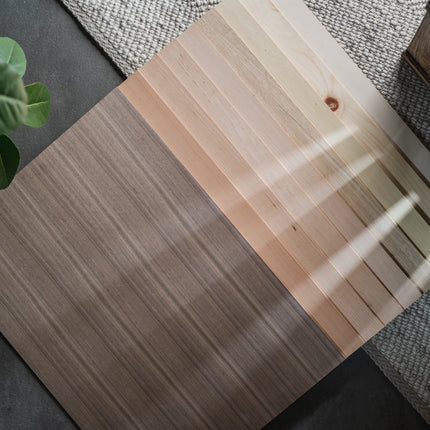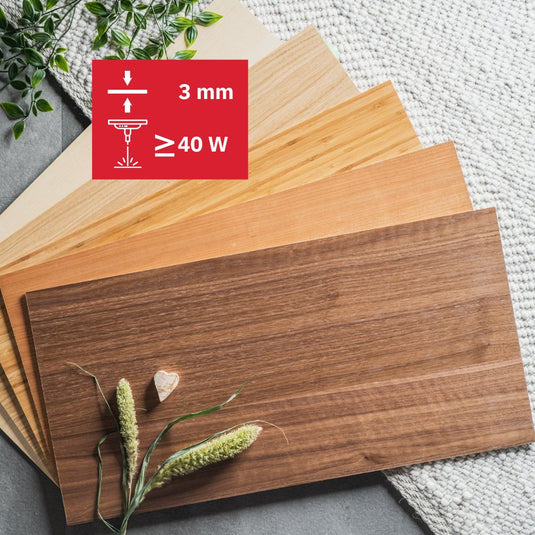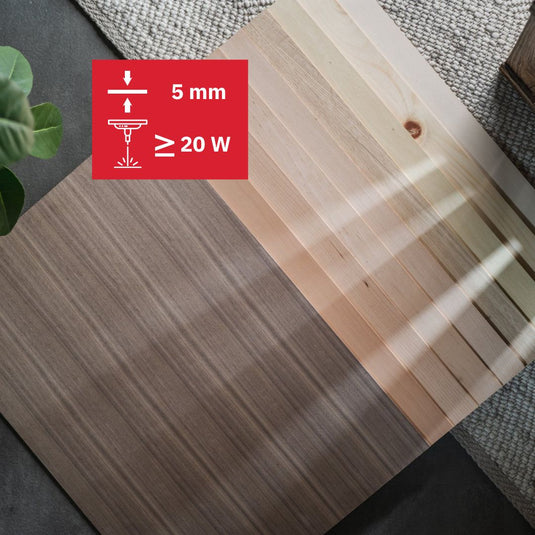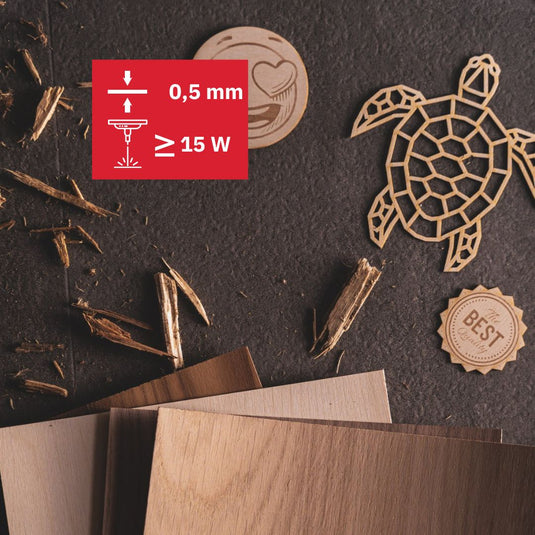
Wood types for laser processing
Wood types for laser processing – The best materials and their advantages
Laser processing of wood is a precise and versatile method used in many areas – from creating fine engravings to complex cuts. However, not every wood is equally suitable for laser processing. In this article, we present the best wood types and explain their specific advantages for laser processing.
Sycamore

Advantages:
- Fine Grain: Sycamore wood has a uniform and fine grain that allows for clean and precise engravings.
- Light Color: The light color of Sycamore offers an excellent contrast to engravings and cuts, which is especially advantageous for detailed designs.
- Hardness: Sycamore is relatively hard, which keeps the edges stable and smooth during cuts.
Beech

Advantages:
- Homogeneous structure: Beech has a homogeneous structure that allows for even processing.
- Robustness: The robustness of Beech makes it ideal for projects requiring durable and stable parts.
- Good contrast: The slightly reddish coloring of Beech offers a nice contrast to the engravings.
Oak

Advantages:
- Strong grain: Oak wood has a distinctive grain that enhances decorative effects.
- Durability: Oak is very durable and suitable for long-lasting applications.
- Aesthetics: The dark, pronounced lines of Oak give engravings and cuts a special depth and dimension.
Alder

Advantages:
- Soft wood: Alder is relatively soft, allowing for fast and easy laser processing.
- Even coloring: The even coloring of Alder ensures consistent results in engravings and cuts.
- Good value for money: Alder is cost-effective yet of high quality, ideal for larger projects.
Pear

Advantages:
- Fine texture: Pear wood has a fine texture that allows for very detailed engravings.
- Stability: Despite its fineness, Pear is stable and hardly warps.
- Elegant color: The reddish-brown color of Pear gives projects a noble appearance.
Hornwood

Advantages:
- Extremely hard: Hornwood is very hard and resilient, ideal for precise cuts.
- Dense structure: The dense structure allows for fine details in engravings.
- Durability: The robustness of Hornwood makes it ideal for long-lasting applications.
Walnut

Advantages:
- Dark color: Walnut has a dark, rich color that provides strong contrast to engravings.
- Elegant grain: The elegant grain of Walnut gives every project a luxurious look.
- Stability: Walnut is stable and resists deformation well.
Cherry

Advantages:
- Reddish tone: Cherry wood has a beautiful reddish tone that highlights engravings.
- Fine grain: The fine grain of Cherry allows for detailed and precise processing.
- Good workability: Cherry is easy to work with yet stable.
Alpin pine

Advantages:
- Aromatic scent: Alpin pine wood has a pleasant scent that gives the processed products an additional, sensual dimension.
- Soft texture: The soft texture of Alpin pine makes it easy to work with.
- Natural resistance: Alpin pine is naturally resistant to pests, ideal for durable products.
In which products can these wood types be found?
- Precious HDF
- Precious Plywood
- Smoothy-Ply
- Precious Plywood
- Precious Uniply
- Veneer paper
- Cardboard-backed woodveneer
- Wood stickers
- Solid wood
Conclusion
Choosing the right wood for laser processing depends on the specific requirements of your project. Sycamore, Beech, Oak, Alder, Pear, Hornwood, Walnut, Cherry, and Alpin pine each offer unique advantages that make them excellent candidates for various applications. By leveraging the properties of these wood types, you can maximize the quality and precision of your laser processing projects. Discover the diverse possibilities of wood laser processing and let your creativity run free!
Be the first to hear about news!
Promotions, new products and special offers. Directly in your inbox.





